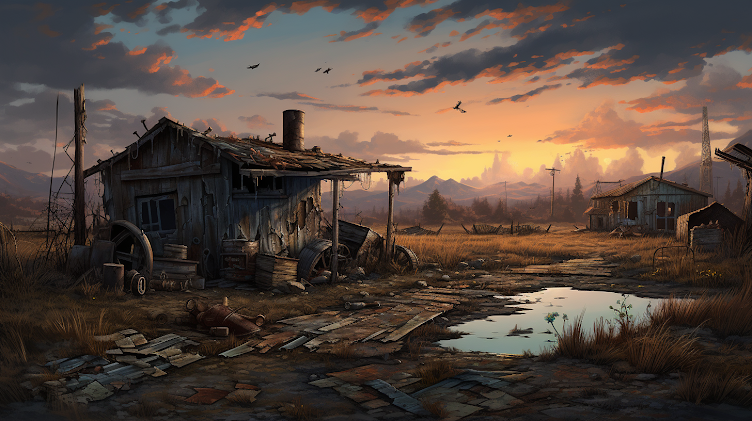In the campaign setting I'm proposing, the collapse is only a short time in the past (or still ongoing, depending on when your personal campaign begins), so scavenging through ruins for food and other basic supplies is a viable survival strategy.
A character can choose to dedicate a day to scavenging and make a Survival roll. This roll can only be made in an urban area. On a success, the character draws a card to determine what useful goods he has discovered. The GM then draws a second card to see if the hero has suffered a random encounter; on a clubs card, a random encounter occurs.
Suit Scavenged Goods
Clubs Medicine
Diamonds Components
Hearts Food
Spades Weapons or ammo
Joker Cache (see below)
Card Quantity
2 1 unit or broken archaic weapon
3-6 2 units or damaged archaic weapon
7-10 3 units or intact archaic weapon
J 5 units or broken firearm
Q 5 units or damaged firearm
K 5 units or intact firearm
A 10 units or intact firearm with full ammo
Joker Cache
Caches: A cache is a veritable goldmine of useful objects, food, and ammo. Such hoards hold 2d6+10 units of one resource, plus 1d6 of another; for weapons, the hoard contains 1d6 intact firearms and 2d6+10 units of ammo. Unfortunately, such caches tend to be swarmed, guarded, or both. For the second card after a Joker, any card is a random encounter except for another Joker. A two-Joker draw is an unguarded cache. Time to celebrate! If the second card is clubs, then the GM either doubles the numbers in a random encounter or takes two different random encounters and adds them together.
In the wilderness, a character can still use the Survival skill to find food for himself and his companions (as per the Survival skill description), but he must still draw a card to determine if he suffers an encounter.
Building Weapons: A character can build a new archaic weapon out of mechanical components. For an archaic weapon, the number of components needed is equal to half the maximum damage of the weapon. (So, a sword that does d8 damage requires 4 mechanical components to build.) Building a new firearm takes a similar number of mechanical components, plus half as many chemical components. (So, a firearm dealing 2d6 damage requires 6 mechanical components and 3 chemical components.) Building a new weapon requires twice as many hours as the weapon’s damage die. (So, 4d6 hours of work for a 2d6 damage firearm.)
Building Explosives: An explosive requires half as many chemical components as its damage dice, plus 1 mechanical component per die. (So, a Molotov cocktail inflicting 1d6 damage requires 3 chemical components and 1 mechanical component, while a 3d6 damage grenade requires 9 chemical components and 3 mechanical components.)
Generators: A survivor enclave’s greatest prize is often its electrical generator. Keeping it active is a daily chore, though. For every 10 survivors in an enclave, a generator requires 1 chemical component per day to keep it running. Keeping the generator in good working order also requires 1 electronic component and 1 mechanical component per week of operation. The generator will not work at all without chemical components. Each week without electrical or mechanical components requires a Repair check at –1 for each missing component type, and a cumulative –1 for each week of jury-rigged operation. A failed check results in an inoperative generator; it can be repaired with tools, a workshop, and 2d6 hours of work, as well as 2d6 electrical components and 2d6 mechanical components.
Tools and Workshops: Repairing an object requires tools, while building a new one requires tools and a workshop. Improvised tools impose a –2 penalty on Repair checks, which is cumulative with a –2 penalty for an improvised workshop.
Weapon Breakage
A common problem in the zombie apocalypse genre is that a hero’s weapons suffer damage with use and need to be repaired or replaced. In this campaign setting, if a hero rolls snake eyes (a critical failure) on an attack roll with a weapon, it becomes damaged (in addition to any other consequences); rolling a 1 on the skill die (regardless of the Wild Die) makes a damaged weapon broken. A damaged weapon suffers –2 on attack rolls with the weapon, while a broken weapon cannot be used effectively until repaired or replaced.
Fixing a damaged weapon requires a Repair roll and 1d6 hours of work, in addition to the components needed (see above). A raise on the Repair roll halves the number of needed components (minimum 1). Fixing a broken weapon doubles amount of time needed for the job and increases the number of necessary components by 1. A survivor can choose to break down a broken weapon for parts rather than repairing it. A successful Repair roll turns a broken weapon into 1 component of the appropriate type.
More to come!
